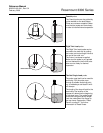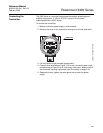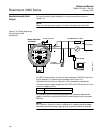
Reference Manual
00809-0100-4811, Rev CA
February 2006
3-21
Rosemount 3300 Series
ELECTRICAL
INSTALLATION
Cable/conduit entries The electronics housing has two entries for ½ - 14 NPT. Optional M20×1.5
and PG 13.5 adapters are also available. The connections are made in
accordance with local or plant electrical codes.
Make sure that unused ports are properly sealed to prevent moisture or other
contamination from entering the terminal block compartment of the electronics
housing.
NOTE!
Use the enclosed metal plug to seal the unused port.
Grounding The housing should always be grounded in accordance with national and
local electrical codes. Failure to do so may impair the protection provided by
the equipment. The most effective grounding method is direct connection to
earth ground with minimal impedance. There are two grounding screw
connections provided. One is inside the Field Terminal side of the housing
and the other is located on top of the housing. The internal ground screw is
identified by a ground symbol: .
NOTE!
Grounding the transmitter via threaded conduit connection may not provide
sufficient ground.
NOTE!
In the Explosion-proof/Flame-proof version the electronics is grounded via the
transmitter housing. After installation and commissioning make sure that no
ground currents exist due to high ground potential differences in the
installation.
Cable Selection Use shielded twisted pair wiring for the Rosemount 3300 Series in order to
comply with EMC regulations. The cables must be suitable for the supply
voltage and approved for use in hazardous areas, where applicable. For
instance, in the U.S., explosion-proof conduits must be used in the vicinity of
the vessel. For the ATEX flame proof approval version of the 3300 Series,
suitable conduits with sealing device or flame proof (EEx d) cable glands must
be used depending on local requirements.
Use 18 AWG to 12 AWG in order to minimize the voltage drop to the
transmitter.
Hazardous Areas When the 3300 transmitter is installed in hazardous area, local regulations
and specifications in applicable certificates must be observed.


















